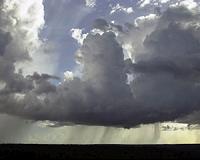| . |  |
. |
Fort Collins, Colo. (UPI) Sep 28, 2010 The oldest trees on the planet, some almost 5,000 years old, are under threat from two enemies in their Western U.S. mountain sanctuaries, scientists say. Bristlecone pines, including one tree named Methuselah that is 4,800 years old, are up against two enemies: white pine blister rust, an Asian fungus that came to the United States from Asia by way of Europe 100 years ago, and an outbreak of native pine bark beetle accelerated by warming in the high-elevation West, The New York Times reported Tuesday. Bristlecone pines grow at high elevations in California, Nevada and Utah. Blister rust is a new threat for the bristlecones. It spread to Europe from Asia in the 19th century and entered the East and West Coasts of North America around the turn of the last century on nursery trees. Only now is it reaching the high-elevation bristlecone. "Neither the bristlecones nor their ancestors have been faced with a disease like this, and they have not evolved tolerances," Anna Schoettle, a Forest Service ecologist in Fort Collins, Colo., said. "So really we're in uncharted territory," she said. The fungus and the beetles together are especially deadly, Schoettle said. "Blister rust kills young trees rapidly," she said. "The mountain pine beetle only kills the larger trees, but those are the trees that produce the seeds. "So when you have a combination of blister rust and the beetle, that severely constrains recovery of the population."
earlier related report "The fire in the Rio Blanco y Negro preserve has burned up 27,000 hectares," said Santa Cruz sustainable development chief Manlio Rocha. "Now it is advancing toward the south; it cannot be controlled." And "the fire is threatening all plant and animal life," he added. "Drought has caused this surge in fires and forecasts are for them to continue through December. We have to be sorry for the loss of forest cover, of biodiversity -- in addition to people's health," Rocha said. Bolivia, South America's poorest nation, is ill equipped to fight the crisis. "Are we equipped to fight fires? No we are not," President Evo Morales said in August. "In all the years of our country's life, we still have no equipment for fighting (forest) fires."
earlier related report The 251-page "ecosystem profile" was launched by Critical Ecosystem Partnership Fund, including the US-based NGO Conservation International, the World Bank, the government of Japan and the Global Environment Facility (GEF). It highlights six "priority areas" that, its authors hope, will encourage protection against human incursion, unsustainable tourism, water extraction, pollution and other perils. They include more than three million hectares (6.7 million acres) of Mediterranean wetlands and desert in Egypt and Libya, home to more than 100 endemic plant species and the critically endangered Egyptian tortoise, Testudo kleinmanni. Other regions include the Atlas mountains of Morocco and the Tell Atlas of Algeria and Tunisia; the Orontes Valley and Lebanon Mountains in Lebanon, Syria and Turkey; lakes, mountains and coastlines in the Southwest Balkans; and Turkey's Taurus Mountains, which contains examples of almost all of the Mediterranean's varied habitats. Guven Eken of Turkey's nature association, Doga Dernegi, which led the work, said the Mediterranean was "hugely complicated" for conservation work. "It covers 34 countries with numerous different languages, alphabets, cultures and religions," Eken said in a press release. "It is also seriously threatened, with only five per cent of native habitat remaining... Much damage has already been done, but finally we have a strategy which transcends national boundaries and can protect this incredible place." The initiative is being supported by what is described as a first instalment of 10 million dollars to help biodiversity conservation over the next five years. Under Target 7b of the Millennium Development Goals, UN states pledged to achieve by 2010 "a significant reduction" in the rate of wildlife loss. Yet every expert assessment points to accelerating declines in many species, ravaged by habitat loss, hunting or the suspected impact of climate change. The Mediterranean basin is home to nearly half a billion people and visited by more than 220 million tourists each year. Members of the UN's Biodiversity Convention meet in Nagoya, Japan, from October 18 to 29, with the task setting new targets to halt the downward spiral.
Share This Article With Planet Earth
Related Links Forestry News - Global and Local News, Science and Application
 The Amazon Rainforest - A Cloud Factory
The Amazon Rainforest - A Cloud FactoryMainz, Germany (SPX) Sep 23, 2010 The air above the Amazon rainforest is cleaner than almost anywhere else on earth. This allows climate scientists to investigate cloud condensation under natural conditions. The results of this study may serve as a point of reference for future analyses of anthropogenic influence on cloud evolution and precipitation. Scientists from the Max Planck Institute for Chemistry have now made a va ... read more |
|
| The content herein, unless otherwise known to be public domain, are Copyright 1995-2010 - SpaceDaily. AFP and UPI Wire Stories are copyright Agence France-Presse and United Press International. ESA Portal Reports are copyright European Space Agency. All NASA sourced material is public domain. Additional copyrights may apply in whole or part to other bona fide parties. Advertising does not imply endorsement,agreement or approval of any opinions, statements or information provided by SpaceDaily on any Web page published or hosted by SpaceDaily. Privacy Statement |